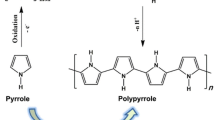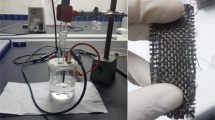Abstract
A detailed study of the effects of different electropolymerization methods on the supercapacitive properties of polypyrrole (PPy) thin films deposited on carbon cloth is reported. Deposition mechanisms of PPy thin films through cyclic voltammetry (CV), potentiostatic (PS), and galvanostatic (GS) modes have been analyzed. The resulting PPy thin films have been characterized by X-ray photoelectron spectroscopy (XPS), SEM, and TEM. The electrochemical properties of PPy thin films were investigated by cyclic voltammetry and galvanostatic charge/discharge. The results showed that the different electrodeposition modes of synthesis significantly affect the supercapacitive properties of PPy thin films. Among different modes of electrodeposition, PPy synthesized by a potentiostatic mode exhibits maximum specific capacitance of 166 F/g with specific energy of 13 Wh/kg; this is attributed to equivalent proportions of the oxidized and neutral states of PPy. Thus, these results provide a useful orientation for the use of optimized electrodeposition modes for the growth of PPy thin films to be applied as electrode material in supercapacitors.









Similar content being viewed by others
References
Mane AT, Navale ST, Patil VB (2015) Room temperature NO2 gas sensing properties of DBSA doped PPy-WO3 hybrid nanocomposite sensor. Organ Electron 19:15–25
Yang J, Cho M, Pang C, Lee Y (2015) Highly sensitive non-enzymatic glucose sensor based on over-oxidized polypyrrole nanowires modified with Ni(OH)2 nanoflakes. Sens Actuators B-Chem 211:93–101
Merisalu M, Kahro T, Kozlova J, Niilisk A, Nikolajev A, Marandi M, Floren A, Alles H, Sammelselg V (2015) Graphene-polypyrrole thin hybrid corrosion resistant coatings for copper. Synt Met 200:16–23
Hou J, Zhu G, Xu J, Liu H (2013) Anticorrosion performance of epoxy coatings containing small amount of inherently conducting PEDOT/PSS on hull steel in seawater. J Mater Sci Technol 29(7):678–684
Wang K, Zhang X, Li C, Zhang H, Sun X, Xu N, Ma Y (2014) Flexible solid-state supercapacitors based on a conducting polymer hydrogel with enhanced electrochemical performance. J Mater Chem 2(46):19726–19732
Huang J, Yang Z, Yang B, Wang R, Wang T (2014) Ultrasound assisted polymerization for synthesis of ZnO/Polypyrrole composites for zinc/nickel rechargeable battery. J Power Sources 271:143–151
Otero TF, Angulo E, Rodriguez J, Santamaria C (1992) Electrochemomechanical properties from a bilayer - polypyrrole nonconducting and flexible material artificial muscle. J Electroanal Chem 341(1-2):369–375
Sadki S, Schottland P, Brodie N, Sabouraud G (2000) The mechanisms of pyrrole electropolymerization. Chem Soc Rev 29:283–293
Dubal DP, Ayyad O, Ruiz V, Gomez-Romero P (2015) Hybrid energy storage: the merging of battery and supercapacitor chemistries. Chem Soc Rev 44:1777–1790
Dubal DP, Kim JG, Kim Y, Holze R, Lokhande CD, Kim WB (2014) Supercapacitors based on flexible substrates: an overview. Energy Technol 2:325–341
Dubal DP, Lee SH, Kim JG, Kim WB, Lokhande CD (2012) Porous polypyrrole clusters prepared by electropolymerization for a high performance supercapacitor. J Mater Chem 22:3044–3052
Holze R, Wu YP (2014) Intrinsically conducting polymers in electrochemical energy technology: trends and progress. Electrochim Acta 122:93–107
Jing S, Xing S, Yu L, Zhao C (2007) Synthesis and characterization of Ag/polypyrrole nanocomposites based on silver nanoparticles colloid. Mater Lett 61:4528–4530
Ravichandran S, Nagarajan S, Kokil A, Ponrathnam T, Bouldin RM, Bruno FF, Samuelson L, Kumar J, Nagarajan R (2012) Micellar nanoreactors for hematin catalyzed synthesis of electrically conducting polypyrrole. Langmuir 28:13380–13386
Wang J, Xu Y, Wang J, Zhu J, Bai Y, Xiong L (2014) Study on capacitance evolving mechanism of polypyrrole during prolonged cycling. J Phys Chem B 118:1353–1362
Zhang Y, Li M, Yang L, Yi K, Li Z, Yao J (2014) Facilely prepared polypyrrole-graphene oxide-sodium dodecylbenzene sulfonate nanocomposites by in situ emulsion polymerization for high-performance supercapacitor electrodes. J Solid State Electrochem 18:2139–2147
Temmer R, Must I, Kaasik F, Aabloo A, Tamm T (2012) Combined chemical and electrochemical synthesis methods for metal-free polypyrrole actuators. Sensor Actuat B-Chem 166:411–418
Zhang J, Kong L-B, Li H, Luo Y-C, Kang L (2010) Synthesis of polypyrrole film by pulse galvanostatic method and its application as supercapacitor electrode materials. J Mater Sci 45:1947–1954
Peres RCD, Pernaut JM, Depaoli MA (1991) Polypyrrole dodecyl-sulfate—effects of different synthesis conditions. J Polym Sci Pol Chem 29:225–231
Marcos ML, Rodriguez I, Gonzalez-Velasco J (1987) Mechanism of formation of polypyrrole on a pt electrode from aqueous-solutions. Electrochim Acta 32:1453–1459
Licona-Sanchez TJ, Alvarez-Romero GA, Mendoza-Huizar LH, Galan-Vidal CA, Palomar-Pardave M, Romero-Romo M, Herrera-Hernandez H, Uruchurtu J, Juarez-Garcia JM (2010) Nucleation and growth kinetics of electrodeposited sulfate-doped polypyrrole: determination of the diffusion coefficient of in the polymeric membrane. J Phys Chem B 114:9737–9743
Su N, Li HB, Yuan SJ, Yi SP, Yin EQ (2012) Synthesis and characterization of polypyrrole doped with anionic spherical polyelectrolyte brushes. Express Polym Lett 6:697–705
Ruangchuay L, Schwank J, Sirivat A (2002) Surface degradation of alpha-naphthalene sulfonate-doped polypyrrole during XPS characterization. Appl Surf Sci 199:128–137
Santos MJL, Brolo AG, Girotto EM (2007) Study of polaron and bipolaron states in polypyrrole by in situ Raman spectroelectrochemistry. Electrochim Acta 52:6141–6145
Kiefer R, Temmer R, Aydemir N, Travas-Sejdic J, Aabloo A, Tamm T (2014) Electrochemistry of interlayer supported polypyrrole tri-layer linear actuators. Electrochim Acta 122:322–328
Mi H, Zhang X, Ye X, Yang S (2008) Preparation and enhanced capacitance of core-shell polypyrrole/polyaniline composite electrode for supercapacitors. J Power Sources 176:403–409
Li J, Cui L, Zhang X (2010) Preparation and electrochemistry of one-dimensional nanostructured MnO2/PPy composite for electrochemical capacitor. Appl Surf Sci 256:4339–4343
Yang C, Liu P, Zhao Y (2010) Preparation and characterization of coaxial halloysite/polypyrrole tubular nanocomposites for electrochemical energy storage. Electrochim Acta 55:6857–6864
Kim BC, Too CO, Kwon JS, Bo JM, Wallace GG (2011) A flexible capacitor based on conducting polymer electrodes. Synthetic Met 161:1130–1132
Lewandowski A, Olejniczak A, Galinski M, Stepniak I (2010) Performance of carbon-carbon supercapacitors based on organic, aqueous and ionic liquid electrolytes. J Power Sources 195:5814–5819
Taberna PL, Simon P, Fauvarque JF (2003) Electrochemical characteristics and impedance spectroscopy studies of carbon-carbon supercapacitors. J Electrochem Soc 150:A292–A300
Daniel VV (1967) Dielectric relaxation. Academic Press, London and New York, p 281
Acknowledgments
CAPES Foundation, Ministry of Education of Brazil: Process BEX 3196/14-3. Spanish grant MAT2012-39199-C02-01 is also acknowledged.
Author information
Authors and Affiliations
Corresponding authors
Additional information
Dedicated to José H. Zagal on the occasion of his 65th birthday in appreciation of his contributions to electrocatalysis and to the general development of our electrochemical science in Chile and beyond.
Rights and permissions
About this article
Cite this article
Wolfart, F., Dubal, D.P., Vidotti, M. et al. Electrochemical supercapacitive properties of polypyrrole thin films: influence of the electropolymerization methods. J Solid State Electrochem 20, 901–910 (2016). https://doi.org/10.1007/s10008-015-2960-2
Received:
Revised:
Accepted:
Published:
Issue Date:
DOI: https://doi.org/10.1007/s10008-015-2960-2




